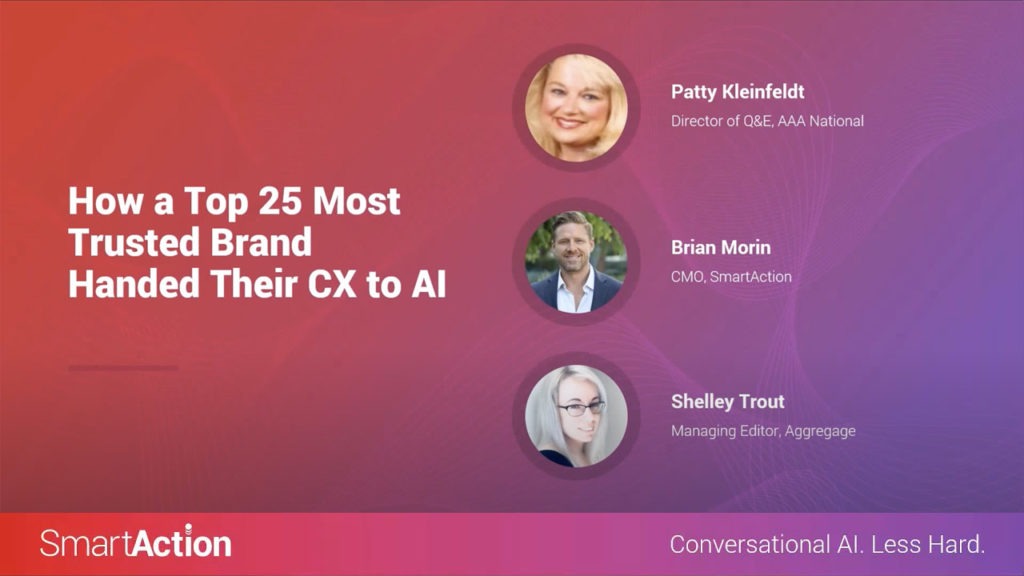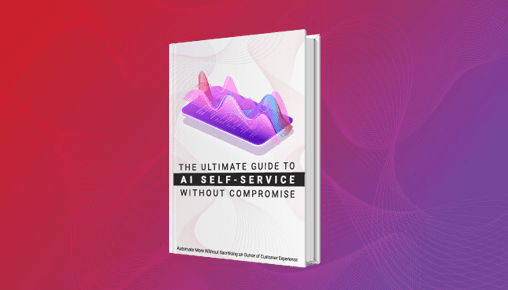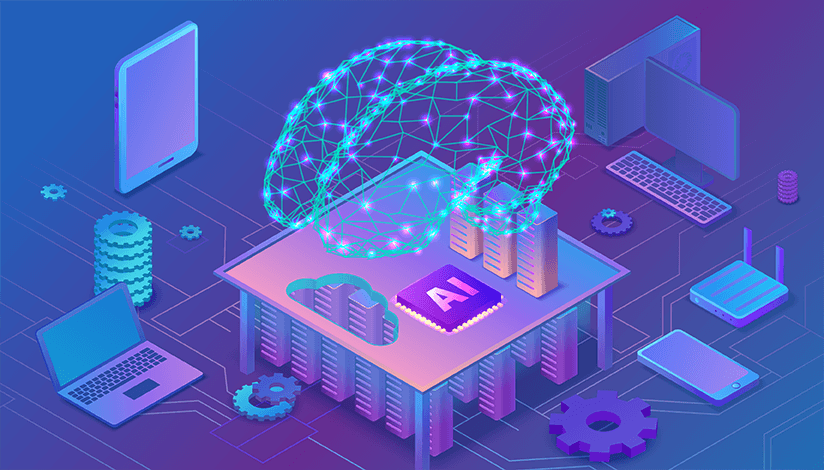How a Top 25 Most Trusted Brand Turned to AI for Business Continuity

When the pandemic hit, a core element of AAA’s business continuity plan was already in place since they turned to AI-powered virtual agents to handle their most precious CX — emergency roadside assistance.
Unexpected winter storms means a spike in call volume, which makes contact center staffing a challenge. Hear how one of the most trusted brands in the world went from skeptic to believer by handing over their CX to AI, and what it meant for their business and members.
What You Will Learn:
- Common pitfalls that AAA avoided
- Key principles for human-centric design that outperforms live agents
- Analysis on bottom line savings and CSAT
- How cloud-based virtual agents seamlessly integrated with AAA’s contact center
Watch This
Webinar

Patty Kleinfeldt
Director of Q&E,
AAA National

Brian Morin
Chief Marketing Officer,
SmartAction

Shelley Trout
Managing Editor,
Aggregage
How a Top 25 Most Trusted Brand Turned to AI for Business Continuity
On-Demand Webinar
Shelley Trout: Welcome everyone, thanks for joining us for today’s webinar presented by Customer Experience Update and Customer Contact Central in partnership with SmartAction.
Today we are with Patty Kleinfeldt, Director of Q & E at AAA. AAA is a top 25 most trusted brand and are going to step us through that journey in handing over their CX to AI as they implemented AI powered virtual agents to automate the entirety of their emergency roadside assistance process from end to end. It is quite a complex interaction as you’re going to find out.
Also with us is Brian Morin, who is the CMO at SmartAction. They are a provider of conversational AI for advanced self service capabilities over voice and chat. They operate conversational AI for more than 100 brands including AAA. He’s going to help moderate today’s discussion with AAA.
We have more and more about AI and customer service, but for those organizations still using traditional IVRs or simple chat bots who have yet to make the transition, all of this can be a great big black box.
So AAA and SmartAction are going to try and pull back the veil just a little bit, and step up through the work they’ve done together and what that, ultimately, meant the business from a bottom line savings standpoint, and the all important CX.
We’re slated for 30 minutes today, but as you have questions, please type them into the Q&A box and we’ll answer as we go along, then move to full Q&A at the bottom of the hour. Brian and Patti thank you for being here today. Please take it away.
Brian Morin: Okay.
Shelley Trout: Thank you.
Brian Morin: I appreciate the introduction Shelley. And Patty, of course, it’s our great pleasure having you with us today. Now I know that the topic on screen of today’s webinar, it’s not what we’re all talking about right now in the moment, which is our COVID-19 responses and risk assessments.
Patty I know on the AAA side that this has … You’ll consume quite a bit of bandwidth on your team and across the board. And I think that we’re all kind of having this evolving conversation.
And obviously on your side, you’re looking at the impact of business continuity to contact center operations. Patty, maybe you can even just give us just a little bit of insight on some of the conversations that you’ve been having on the AAA side as you handle this.
Patty Kleinfeldt: Yes, well thank you very much Brian, and I’m happy to be here today. And this is a serious situation as we all are living with today. One of our clubs in Washington state has been hit very hard-
Brian Morin: Yeah.
Patty Kleinfeldt: And they’re actually using the capabilities, not only of other clubs, because we care about our employees and want to make sure they’re safe, and includes our critical contact center employees as well. And not only are we sharing best practices across the country in dealing with the situation-
Brian Morin: Mm-hmm (affirmative).
Patty Kleinfeldt: But we’re also using SmartAction in helping us in those situations where, one we may have employees that are out to the illness, or caregiving, or one of those situations. So, we are in the battle with everybody else.
Brian Morin: Yeah, we are, and we’re on a different side of that battle, dealing and clearly on this end of it where, to some degree, AI could step in almost as a little bit of a Red Cross moment for some of those contact center operations that might otherwise be disrupted.
I think in the situation the University of Wash- … Not the university but the state of Washington, it happened so quickly with their stay at home policy that to some degree, some contact centers have been able to scramble to get their plans in place if they weren’t fully there. But in the case of the state of Washington, that just happened so quickly I think it caught all of us off guard.
Patty Kleinfeldt: Yeah it absolutely did. And SmartAction does a really good job of partnering with us too. And I’m not trying to make this just a commercial first SmartAction, but they really do. They do a great job with partnering with us, and they’ve been working hand in hand with our Washington the club to help them solve some of those business challenges –
Brian Morin: Right.
Patty Kleinfeldt: as we speak.
Brian Morin: Right, absolutely. Well I know that those that did join in for this discussion. So we’ll go ahead and we’ll jump into it and, of course, we’re open to any Q&A or comments or questions as we go along. So those that have any kind of broader spectrum questions, even about AAA and what they’re doing in their preparations and precautions, of course feel free to chime in.
You might wonder before we jump, well who is SmartAction? And just to give a little bit of context … I don’t like long company overview slides, so I’ll just make this super quick. The only need to know on screen is that we provide AI powered virtual agents, we do it as a service. So that means that we bundle the full conversational AI technology stack together with end-to-end CX services.
All those services needed to run it and that means everything that designed to build the ongoing operation and. And so for most you, that means starting in voice for the biggest ROI, and then scale digitally to chatter text.
And I think that will contextualize this as we go along, but the bigger point to be made is that with conversations with machines, they’re not easy. So it’s not just design, build, and poof, you’re done, and that’s why you do need a team of specialists that are committed to tuning the application week by week, which we’ll talk about just a little bit in AAA’s journey as Patty will let us in on.
And it means doing things like pointing to data analytics, listening to call recordings, meeting with teams weekly on staff objectives, and constantly iterate and change that frictionless experience. So just to set the table here, Patty, we just kind of put up on screen just some top level stats related to the AAA. I think everybody that’s joining in, everybody knows AAA and what AAA is about. Maybe you can tell us just a little bit about new contact center operations.
Patty Kleinfeldt: Yes, well we have contact center operations all over the country, in every state, and in Canada, as well as part of our association. And we conduct millions and millions of … Even in the automotive side, not including the travel and membership side, take care millions of emergency road service calls every year. So I believe we have over 100 contact centers in the United States and Canada.
Brian Morin: Okay, so the big takeaway is that AAA is handling a lot of member calls each day. To set the table here on what we’re going to get into is a kind of like the core capabilities of conversational AI. I think that you can see that on screen, just giving you a little bit of idea what those capabilities are.
If I were to stand at a 50,000 foot level, essentially all the tools required to mimic live agent behavior, at least when it comes to those types of interactions that are more transactional in nature. Those high volume repetitive calls that are linear, and such is the case as we’re going to get into with AAA when we talk about their emergency roadside assistance service.
You can see the piece on screen the recognition and cognition, these are the two different AI technology stacked on top of the other one as a recognition piece, mapping out objects or sound waves to word. And then the second piece is the back end cognition or the stitching, if you will, that can extract intent from what was heard.
So this means breaking sentences apart to parse words and phrases. We do this with AAA in, “How can I help you today?” As an open ended conversational greeting. Now we will make suggestions, you can say things like … And we may give a couple of suggestions just to help the user know how they should interact with the system.
We’re listening for many things, but by offering a couple ways to interact with the system that helps somebody respond a little more succinctly, and then give a two minute answer to that question. But it’s basically all the tools needed to mimic live agent behavior in a conversation that is linear in nature.
So Patty, let’s go ahead and kind of talk a little bit about AAA’s journey. Obviously, that there was a point when all of these calls were being handled by live agents, customer service reps. And I know that you and I chatted prior, you were involved in that original team that saw SmartAction begin to integrate within AAA, and then saw it being used more broadly throughout. Let’s talk about that tipping point, and particularly some of these challenges related AAA, and how in the world you staff these contact centers when you really can’t prognosticate the weather?
Patty Kleinfeldt: Exactly. We had a Canadian club back starting in 2012 that came to us, and one of their biggest challenges is that they were seeing a large amount of weather incidences, and road service events; this can significantly impact our call volume. And so they were kind of looking for a solution to help them with that because they couldn’t possibly staff to all these events that were occurring at the time. Our roadways are becoming more congested, we’re having much more weather events, and so on.
So their first step into exploring how artificial intelligence powered virtual agents could assist AAA, we thought, “Boy, this is really something that we need to look into to help us serve our members.” So with that, we needed a good solution that can maintain or even increase, or provide a better service experience than we were having currently. Because we didn’t want our members on these long hold times-
Brian Morin: Yeah.
Patty Kleinfeldt: Till we could get to them. And so this kind of really helped us to be able to provide a solution where if they were at home, or they were in a safe location, they could use the SmartAction solution and still get service just as they would if they were talking to a live agent. We could use our live agent to really help our members that were in more dire situations and needed that hands on experience with an agent.
Brian Morin: Right so –
Patty Kleinfeldt: So we just started that with our Canadian club in 2013.
Brian Morin: And in this case it wasn’t as though that you weren’t wanting to talk to your members, it has more to do with the fact that if there’s like a winter storm that rolls in, and you’re not properly staffed to the max to handle that, or be prepared for that at any given moment, that put somebody in a situation where they’re just waiting on hold to speak to somebody. And I can imagine that’s a difficult experience for somebody who is feeling like they are in dire situation.
Patty Kleinfeldt: Exactly. And then there was no way to prioritize the calls in a very good fashion in those situations. So you had members that were on hold, and we just wanted to really improve that experience for members, and that’s how this all started.
Brian Morin: Right. Well, so let’s kind of talk about your first exposure to you handing over your most precious CX, your emergency roadside assistance service. And how does a top 25 brand kind of walk the plank, or make that leap to say, “We’re going to hand our CX over to AI, your most precious CX over to AI?
And I know, Patty, that initially there certainly had to been a number of hesitations related to that; we put a few of those on screen here. How does this impact the or seize that? Is it actually going to deliver on the promise? Some of these hesitations, clearly, they had to been in mind when you were looking at this initially with you and the rest of your team. And were these some of the same questions that you were asking?
Patty Kleinfeldt: Oh, absolutely. And just to make everyone aware, we celebrated 118 years of business, being in business this year. So at the time we’re looking at this solution, we’re 111 year old company, we have outstanding member satisfaction and retention scores and, of course, we don’t want to do anything to upset that. We always want to grow it, and member satisfaction, and retention.
So we really took a hard look at where we could begin with a solution, and test its capabilities without impact to any type of customer service experience. So we weren’t going to take any chances to negatively impact those member experiences.
On the other hand, we also wanted to use technology as a tool to help expand and increase our positive member experiences. We did start out small with a small Canadian Club, and we used it to start out with our blowout days and bad weather days as our starting point.
Brian Morin: Yeah, so Patty … I’m sorry, go ahead. Did I cut you off?
Patty Kleinfeldt: And I was going to say, and then we increased from there because we’ve been working with you all as a partner with us for over six years. So we take member calls using the SmartAction solution, and several different types of calls that we continue to explore.
Brian Morin: Right, gotcha. So you and I chatted about this before that a lot of customers talk about their own arc of journey, you’re kind of going from skeptic to believer when it comes to implementing conversational AI technology. How was that for you and for AAA as a whole? Was this a similar arc that you had to walk through?
Patty Kleinfeldt: Oh I think absolutely. Oh I can remember all of the conference calls we had, and talks, and you have a lot of skeptics in that in trying to, especially, bring in new technological solutions; so we did have a lot of skeptics.
But we started the process out with our challenge, and our challenge was having enough agents and called counselors to answer the phones, especially in those blow out days. And believe you me when I tell you we have them year round from … It’s not just winter, it’s the summer as well.
So we still had answering member calls every day, we have live ages that still do that, and we did at the time, but we wanted to start out at getting the skeptics and believers. So again we started out small, and we ran pilots to test the technology.
Brian Morin: Sure.
Patty Kleinfeldt: And we started out with members that, again, were at home or in a safe location to use the automated service.
Brian Morin: Gotcha. Well so this is why we brought in Philll Fisher, who is the CSM, who’s the point of contact here at SmartAction working with the AAA team. And Philll, do we have you on line right now?
Philll Fisher: Yeah, good morning everybody.
Brian Morin: Thanks, Philll. So one thing we’re going to do is just step through, at least from the audience perspective, let’s just talk about what does that CX look like, what does that journey look like when somebody engages emergency roadside assistance? When you get under the covers, this is a little more complex than you realize that it even is from the outside.
And Phill I know from the very start, there might be some clubs that are using a voice and chat solution … Well, maybe some are using voice only. But across the board, somebody can engage either voice or chat.
I know the first piece of this … Perhaps you could just kind of step us through as you see this conversation flow in some of these key milestones that are actually occurring in this process begins with authentication. And I do know that there are a couple business rules in play because Patty, obviously, one thing important for AAA is making sure something should only go into automation if it deserves to be in automation to make sure it goes down the happy path.
You have mentioned initially if they were at home in a safe location, I know, Phill, we’re also looking for a couple other things like is their membership active, you’re doing a dip into their customer data pool, correct?
Phill Fisher: Correct. Yeah, I mean really the main purpose is ensuring that the experience is exactly what the customer wants. So immediately we ask a lot of these club before they even get to SmartAction, ask if they want to automate that core. So they’ve already chosen us as their preferred method to get their service call answered; so that’s where we start.
And then like you said, we then go through various different stages with the customer’s experience being paramount. We never track them in the application, there is always the option to go to a live agent. There are specific situations that we understand are more serious than one or main service should be handling. If you have a child trapped in the car, if you have a pet trapped in the car, we’re going to immediately get those to where they needs to be.
But if you are able and willing to work with your automated system that’s very successful in capturing all the information necessary to get a tow driver out to you, to get a flat tire repaired, or whatever your needs may be. And it’s not just taken to home members, now we can actually locate you via an interactive SMS text messages that we’ll send you. And that way we can locate people that aren’t necessarily at home, we can get a tow truck driver out to you to your specific location, and then handle all of the ticket that way.
Brian Morin: Now I know I alluded this earlier, we have this intent to capture piece in natural language. Phill, I don’t know if you know off the top of your head, it may be hard to come up with all the things that we’re listening for, but, clearly, we’re listing for some intents as far as a dead battery, or needing a tow, and perhaps some others. And I would suppose some of those intents are intended for self-service, and while other intents, if we capture that, we transfer to a live agent.
Phill Fisher: Absolutely. I mean so first of all, we’ll offer the suggestion like I know you mentioned earlier on in this session. Well offer you can say things like, “Tow, flat tire, out of gas.” And then I will then prompt the member to be more specific.
But we also do have the ability to capture certain sections of what somebody says. So they don’t specifically need to say an exact phrase for us to recognize. If it’s something to do with a battery and we can pick out and paraphrase that out, we can pass that information from that, and just confirm, “Are you talking about a flat battery?” If they then confirm, “Yes.” We go down that path of the call flow.
And if we do get confused, we ask again. If we get confused three times, we will immediately get you to an agent. Again, we don’t want to frustrate a member we understand these are stressful situations. A lot of people, whether they be at home or standing on the side of the road, these are situations where we want them to be calm, and feel as though we’re going to be able to help them.
Brian Morin: Now one of the pieces of complexity here is, of course, its capture and member location. Whether or not you can capture that location over voice intent, or if they’re not sure where they’re at through GPS. But then you’re now by trying to use that to find the location of the nearest service or tow, and Phill even deeper than that is not every intent needs a tow, and then not every intent … Which means that some intents are going to go to other service providers. Somebody who might just show up in a truck to, if it’s just a battery, to recharge a battery. Right?
Phill Fisher: Correct. So there’s gonna be a lot of different business rules that we hear and we need to confirm some things. Immediately we have access to AAA’s data so we can check your home address, we can ask immediately, “Are you at home?” If they say, “Yes.” We know exactly where you are.
Depending on the type of vehicle you have, some are able to be towed by a regular tow truck, some need a flatbed truck. So all of those things, data in the membership that AAA will pass to us in an API call. Immediately if we get the call in, once we’ve confirmed who the member is, and then we can just work off of that and figure out exactly what vehicle we’re talking about.
So that when the tow truck driver … I’m ready to just throw this away. Once the tow truck driver gets the dispatch call, they know exactly where it is, they know what car they’re looking for, they know who the member is so when they get there, it’s a very easy experience. And also you’re stuck on the side of the road at 10 p.m., it’s dark outside, you want to be addressed like the driver knows who you are; so there’s a security element to that as well.
Brian Morin: And one of the interesting pieces here, … We’ll kind of just skim through the rest of this. But the AI will actually call the service provider to find out that they’re able to handle the service and then capture their TA to hand back to the member.
Phill Fisher: Yeah, so we’re now full service, we’ve just gone live in production where we can handle the entire flow of this from a member first calling in to contacting the dispatch driver. They then confirm, all through automation, that they can take this call. We then pass what they’re expected ETA will be, and will also check in on a driver, automatically, through an automated outbound call to say, “Hey, are you still on time?” If they say, “Yes.” Or, “Hey, I’m going to be 30 minutes longer than I thought.” We will then pass that information to the member through another automated call.
So this entire journey can be done without the need of a live agent, so it just allows those live agents to be able to focus on, like Patty said earlier, those more difficult causes really require that the human touch.
Brian Morin: Yep. So, Patty coming back to you. This is a more than 100 year old organization. And, obviously, this is quite a transformation in introducing this as being a cornerstone to your CX with your membership, you’re doing something at the very tip of the spear with AI. Maybe you can step us through just a little bit of some of the key results and observations that you have seen across clubs. We’ve put some of those big KPIs on the screen that we have chatted about before. But I don’t know if there’s anything to add to this.
Patty Kleinfeldt: Yeah, this is great; and that’s very true. We had one of our Canadian clubs actually pointed out that they had higher satisfaction ratings than some of their other channels. They also said they had cost savings of over 56% per call. And then the calls, they can actually complete the calls in half the time it takes some of the outsourced agents they were using at the time. So, again, and today we are using this service on over five plus million calls today.
Brian Morin: Right.
Patty Kleinfeldt: And we didn’t start out this whole journey to save money, we started out to really provide better service.
Brian Morin: Right.
Patty Kleinfeldt: And the cost savings, where we could reinvest back into our call centers and into our staff, was just a bonus on top of that.
Brian Morin: So, I’m going to jump into this slide, and this is actually kind of a more interesting part of the conversation for us to have here, Patty. Because it’s been said that conversational AI is not a product, in the sense of it’s not an IVR where you just design, build and done.
These are conversations with machines, that means it’s your ongoing inner process to improve over time. And we’ve been doing and stepping through that journey and process with you. And maybe you could just kind of speak to this a little bit. For somebody else that has ventured in this area, clearly, all of this is a great big black box. And maybe you can just talk about how helpful is it for you to have a partner in this area.
Patty Kleinfeldt: Oh my gosh, because things are changing all the time, and we have to have that relationship with a partner. Because we might have things changing, and because it connects to our technology as well. So something changes in our technology is going to affect what we’re doing with SmartAction as well.
So SmartAction’s technology connects with our technology, we have enhancements and upgrades, and all the stuff that comes with that; so having a partner in this process is critical. It isn’t, like you said, “Build it and you’re done.” Because we’re changing and evolving all the time.
And I’ve even had some of our key vice presidents contact me and said, “Hey, I had an issue. I called SmartAction, and they were right there and right on it.” So having that partner is critical to use because these are really important services that we provide our membership, and we need to be there for them.
Brian Morin: So, Patty, on screen is what we’ve talked about is most organizations, I mean, they are venturing down the road of expanding self service capabilities with conversational AI. There’s usually one or two paths, it’s either you kind of taking a do it yourself approach; which is procuring your own SAS platform. Then making all the on staff, internal hires to build out of your internal team to handle every aspect of the journey from the application power users, to you might use from a data scientist, back in the analytics, the conversation flow designers.
Or on the side which is a part of which, in our case, we’ve fallen in that category, having that the entirety of that in a CX team, on staff and hand that as a service. As you’re looking down both of these perspectives, Patty, I don’t know if you can even … Clearly, you’ve chosen the path on the right, and I don’t know if you’re able to speak to some of those that are looking down making the choice themselves.
Patty Kleinfeldt: Well, I think, again we started out with a pilot, and we tested it, but for us it’s kind of a no brainer because we really like to partner with … No pun intended, but with smart people that are doing incredible things, especially when it comes to better servicing our membership. So why reinvent the wheel if somebody’s already out there doing it and doing a good job? So that’s definitely … We’ve been in partnership and working with you all for six years.
Brian Morin: Mm-hmm (affirmative).
Patty Kleinfeldt: And we keep growing with you. So I think that’s, that’s a testament to that partnership.
Brian Morin: It is, and the relationship and the technology capabilities continue to evolve.
Patty Kleinfeldt: Yeah.
Brian Morin: So on screen, just for the audiences that are listening in, if you are looking down the path of hey you want to build out your own team, and take the do it yourself approach, this just gives you just a little insight, at least, what to our CX team looks like, because it’s one that we see mirrored in other organizations that are taking a similar approach.
Now we’ve been doing this for a while, so we’ve had some time really curating this team. But as you can see every face on screen is more than just an individual, they actually represent a whole team behind them. We have seven different teams that work cross functionally under different particular CX disciplines; so you can see some of those on screen.
But just to get an idea of what it takes behind the scenes, we would look at this, to some degree, as being the context center of the future where it’s not necessarily a big room of cubicles and clacking keyboards, but it’s a highly skilled, small team working with technology, understanding that human to machine interface, how to adapt them, and really deliver those frictionless experience from one side of your left brain thinkers and your right brain thinkers.
So what I will do is we are going to move to a Q&A, and I will just close out very quickly. If for any reason you are looking at conversational AI right now, we’ll give just a very quick plug on why you might want to consider SmartAction on your short list. And I can keep this just to 30 seconds and not belabor you.
But first at the top is the biggest Patty’s referred to, is that this is a proven solution. We operate conversational AI for more than 100 brands, and we are the top rated solution at the moment on Garter Peer Insights site as rated by our own customer reviews.
But one of the big elements of this is the outsourcing aspect instead of a do it yourself approach, delivering virtual agents as a service. So we’re not stepping in as a technology provider selling software licenses, we deliver that conversational AI technology stack which is ever changing, but we’re delivering it through the hands of a team of CX experts to really give that that human centric design.
So if anyone is interested on engagements on next steps, you can see the email address on screen info@smartaction.com. I’ll hand this over to Shelley in just one second, so she can start going through Q&A. But we find that most people start with either one or two places. One is requesting a demo to hear what we’re doing for other adjacent players that are in your vertical, or we’ll be called for an AI readiness assessment.
You may want us first looking at your interactions with you, looking at those volumes, call voice and chat volumes to find out do they meet the thresholds for change where we can guarantee a great CX and guarantee a very quick ROI. So that said, Shelley, I can throw it back to you.
Shelley Trout: Excellent, thank you so much for this awesome presentation. I have to say as a AAA member myself, I feel a lot better having heard already what just in case I have an emergency in the next couple of weeks.
Patty Kleinfeldt: We’re right there for you, Shelley if you need us.
Shelley Trout: All right, so we have questions coming in. The first one is from Jonathan, and he’s curious to know, “If a call gets transferred over to live agents, do they get transcripts of what the AI heard?” He’s looking to avoid clunky handoffs.
Brian Morin: Sure, so actually feel like that you could mention that we do. I don’t know what that looks like with the AAA, but we do screen pops that get passed along to the live agent, so the live agent can just pick up the conversation where it left off instead of having to repeat authentication, or repeat some of the questions that they heard. I don’t know specifically in the AAA aspect.
Phill Fisher: Yeah, I can answer that, Brian. So we integrate fully with AAA’s internal system, so we actually create a what is called a partial ticket. So whatever information we’ve captured, whether it be just a little, or virtually the entire call that is passed to the agent. And then that’s our job to work with the AAA clubs to make sure that we’re implementing a change management program where we’re training the agents to actually utilize this information.
When we first went live, we were finding it was a little clunky, and it was because we were passing this information, but the agents weren’t necessarily aware that misinformation was available. So we also kind of structured the call in a way that we try and capture as much information as possible, leaving the most common reason for transferring toward the end.
So that once the gets to a live agent, we’re saving huge amounts of agent handle time, because we’ve collected all the information usually it will be the GPS location, and then all the agent does is hop on the call, “Yes Mr. Smith, I understand you’re in need of a tow right now. Can I just confirm your location? Great.” And then we move on.
Shelley Trout: Okay, thanks so much for answering that. The next question today that we have is from Christy, and she’s asking, “Call deflection from live agents to AI agents in year one, two, three; what’s reasonable to expect?”
Brian Morin: Yeah, that’s a good question. I think that for us it depends on what the journey is that the customer is wanting to step through; and that’s different for every customer. We will have some customers who will start very small; so, obviously, that that call deflection might be very low initially. Which means that they’re just wanting to test the experience, and also make sure that they’re seeing the ROI that they would expect.
Now in other cases, we do something for instance … We do Choice Hotels, the second largest hotelier, the umbrella for lots and of brands that you know and are aware of. And we went live with them immediately with the Great Big Bang implementation, handling 13 different interactions from the self-service standpoint.
But the one thing that we do in all of our processes that we will begin with the widest happy path that we can find, and making sure that we’re delivering a great CX. And then we’re monitoring closely what is the number one reason for a live agent transfer, or hang up, looking at data analytics to identify those points of friction? And then we’re digging in and actually listening to call recordings, and then we’re tweaking conversation flows, we’re looking for new data sources that we might add in.
So as you can see, the happy path or the wide path at the virtual agent continues to grow over time, but only as we know that we are delivering a great CX. We never want to start out of the gate trying to automate more than we really can and deliver a subpar CX.
Shelley Trout: Fantastic. It’s really great to hear that you’re so CX focused. I mean, a lot of AI … Like you said before, when you focus in on chat bots and stuff-
Brian Morin: Mm-hmm (affirmative).
Shelley Trout: It really falls short of the customer experience; so it’s really great to hear that. Another question that we have just came in from David he’s wondering, “How often does the AI application need to be tuned?”
Brian Morin: Well Phill when you’re rolling out a new application for a new interaction probably quite a bit; we do see some diminishing returns as time goes on. But Phill, you could just talk about you and your team, you’re meeting with AAA clubs on a weekly basis covering, I guess, objectives, and goals, and what you’re doing next.
Phill Fisher: Yeah, absolutely. So I mean it all initially starts with, obviously, the design team. So the design team worked very diligently to wear the hat of the customer. So, by customer, I mean the person phoning in. They want to design the best experience from the outset, and as soon as we do go live, it’s got a higher monitoring standpoint for us.
We have a team of customer insights experts who are listening to call, they’re crunching the data, they’re looking at where … Like you said earlier, Brian, where people are failing. We can pinpoint by what we call breadcrumbs, we leave little things in the engineering code on the back end that signifies exactly what prompted is that someone’s struggling with it.
If we can find out how to on wording that correctly, or people aren’t understanding what they should say to it, we can immediately kind of go in, make those changes and, obviously, work with the client in saying, “Hey, this is what we’re seeing, get a full approval.” Which AAA especially is very good to us. They trust us, we work with 14 clubs across North America now handling 73% of the call for the entire federation.
So we can just go in and then we finely tune, but it never stops there. This is a living organism, people are changing, technology’s changing, what we have to do is changing; so we’re constantly tuning things.
As I’m sure you’re all aware, there’s new car models come out every single year. We need to keep updating things like that. If we’re hearing someone all of a sudden is referring to a Chevy as something different because it’s got a different name in common culture, that’s something we’d listen for, and then tune appropriately.
So it’s an ongoing thing, you can never stop. We want statistics on finish percentages, on fail out rates and, accordingly, take deeper and deeper dive into the specific cause, including a full QA team, but we listen to the calls every sing day. So it’s a very robust team and, honestly, it’s super important to continue the relationship with the customer, and just make sure that we’re doing what we should do.
Shelley Trout: Amazing, that’s such a great point about how everything is constantly changing, even the way we refer to things in our language. So I’m curious, does this require a full IT integration with client systems, or is this like bolt on technology? How should people think about this?
Brian Morin: Yeah, the one that we hear commonly … So we’re a cloud-based solution. What’s happening in the case with AAA is that when somebody is calling in, they’re on our network, and then if we … on our cloud network. And if we do, you’d need to, for any reason, transfer over to a live agent, well then we’re just transferring that over to the appropriate call center agent.
But what we are doing is we’re API’ing to the same data that your live agents are API’d into, your CRM systems, or in contact center technology. So don’t think of this as the on prem bolt on technology, but we are just using whatever available APIs or web services are already sitting there to tap into the data. Because the data is the lifeblood for the AI to do what it needs to.
Shelley Trout: Fantastic. So it almost sounds like this virtual agent is an outright replacement for the IVR, is that true?
Brian Morin: Oh, well. So in some cases it is. In fact, I’d say maybe in most cases it is, but in other cases it isn’t; in the case of AAA it isn’t. In the case of AAA, I think that there is still the traditional IVR where you’ll come to the system, but should you press the option that’s related to emergency roadside assistance, instead of that call being routed to a live agent, in that case, it would be routed to a SmartAction or virtual agent in that case.
So it just depends how you want to use it. You can use it as an outright IVR replacement if you want open end intent capture from the very beginning, and then use it to route, or keep in self-service. Or you can simply use it to augment whatever IVR that you already have in place and infuse conversational AI capabilities on perhaps your most high volume, or repetitive interactions.
Shelley Trout: Excellent. Okay, our next question’s from Joseph. He’s wondering, “How difficult is this to integrate with our CRM and Genesis platform?”
Brian Morin: Well, so we do have Genesis customers, just like we had FiveNine customers, and Navia customer, and Cisco customers, and Nice In Contact customers. We integrate with any technology that you already have in play, and we are API’ing in to, as I mentioned earlier, API’ing in very easily to those CRM systems.
If it’s a homegrown system, you have web services are available, meaning it’s somebody, you can go on your website and do any type of self service, you’ve exposed that in such a way that we can connect to it. And so it’s not a painful journey by any means.
Shelley Trout: Cool. Another question just came in, “Wondering if the AI uses sentiment analysis during calls? Is that being able to tell if someone’s annoyed?
Brian Morin: Yeah. So we do hear that quite often. We see other players, or adjacent players, in the market bundling with some of those offerings; we haven’t bundled any offering like that into our solution as of yet. So as far as an emotion analysis of what we’re hearing on tonality, something that we’re considering but nothing that we have implemented.
Shelley Trout: Awesome. Kind of backing off of that, this question is from me. I have a hard time sometimes getting American waiters to understand what I’m saying.
Brian Morin: Yeah.
Shelley Trout: How well does your technology work with the accents or non-American accents?
Brian Morin: So I guess we would like to think very good to outstanding. You can go to our YouTube channel, we have lots of different examples there. Part of just what we’ve done as a team on the machine learning side of the house, when we were first tuning our AI brain, if you will, one of the things that we did is grabbed every UN speech has been given, and fed that through our systems to learn from. So in some cases, we will hear from callers that are coming in that we, ourselves, could not understand what they’re saying, but the system can. So that may not have been true three or four years ago, but the advancements of capabilities that we’re seeing on conversational AI landscape have really, really evolved.
Shelley Trout: Wonderful, thanks for mentioning our YouTube channel, Brian, I just popped that link into the chat box for everyone. So if you’re curious about how SmartAction actually use AI in their programs to understand speech patterns, that link should be able to direct you to a whole bunch of extra videos about that. All right, next question’s from Hannah, “Just curious to know if customers start small and grow over time, or are-
Brian Morin: Yeah.
Shelley Trout: These actually big implementations that happens a lot at once?
Brian Morin: Well so Patty, you talked a little, alluded to this earlier. You started very small.
Patty Kleinfeldt: Yeah.
Yes. And as Phill pointed out, now we’re in 14 clubs. So those 14 clubs across the country handle like over five million calls. So yes, we started out small, but we grew pretty fast. I think within 12 to 18 months, we were in quite a few clubs answering quite a lot of calls.
Brian Morin: Yeah.
Shelley Trout: That’s great because then you can kind of add a little bit at a time and let people get used to it, and then add a little bit more. Is that right?
Brian Morin: Yep, that is the methodology that a lot have taken. I know AAA, Patty, you being a top 25 most trusted brands, you don’t just jump in the deep end of the pool right? So you want to start it and monitor closely, which you did.
Shelley Trout: That’s a great point, I think that’s awesome and will make a lot of people feel more secure.
Part of this just has to do with the fact that if you were to step back in the market, and just have an idea of how quickly things have evolved and changed. If you’re trying to do even just a … Now we’re talking Omnichannel, a voice and chat, or text here.
Brian Morin: But in the case … Just three or four years ago, if you were trying to do a voice application, you’re talking about the bit upfront CAPEX investment in speech recognition licenses, the ongoing support fees, all the PS fees to build something. But people weren’t even getting off the ground without spending a million dollars or more.
And things have changed so drastically in that area that it’s just a … In this day and age, just a nominal one time setup fee, and we see organizations that move straight out of their OPEX budget with little, no CAPEX investment at all. And that’s how quickly this whole market category has been shifting.
Phill Fisher: And I’d also add to that Brian, we started out small with the AAAs, and we’re now at a point where AAA will come to us with a business problem, and we’ll work with them to provide a solution that we currently don’t have. But our engineering team works with AAA very closely, and we figure out a solution to the problem.
To give you an example, one that’s come in relatively recently was they were like, “Can we do anything when there are queues?” Or, “We can’t do anything about the queue times for our members, could we, potentially, then just grab a couple of little bits of information to really speed it up, even though they didn’t choose the automated option?” And sure enough, we worked with them about the ability to do this.
It doesn’t take them out of their place in the queue, we just grab a few bits of information, and pass that to the agent. Once they get there again, that just speeds things up and saves agent handle time. So we’re constantly trying to work with the clubs on, “What is your problem? Was affecting your cross hairs? How can we help?”
Shelley Trout: Fantastic. Thanks again for that little bit of extra detail; love it. All right, last question that we have here today is about your competitor’s offerings, “Are your competitor’s offerings like AWS Salesforce Einstein, IBM Watson, or any others?”
Brian Morin: Yeah. So you certainly can. I think that we might be hard to call that a competitor’s offering, that’s just more of a do it yourself platform and approach. Salesforce Einstein was mentioned, I don’t think that there’s any voice aspect to that, I believe that that is chat only.
But there is Omnichannel, certainly with an IBM Watson, or if you’re going down the road with an Amazon. But you do have to keep in mind, you’re going down those roads means it’s building out your own internal CX team to support those.
And we have yet to see an organization … Unless maybe they’re doing something very, very simple over just one channel, it takes multiple bodies to you get what you need from those systems from a CX standpoint to really handle those interactions.
And it just comes down to a cost justification to find out do you think you could build out that team and then do it more inexpensively than you could with an outsourced partner? Because you are talking full-time headcount for each of those different roles you might need in those areas.
So it might make sense for a top four financial firm, but for your other organizations that fall under that, I think it makes these platforms and approaches very difficult unless you are working, potentially, with a partner. We’re not the only one, but we’re certainly one of them to be considered.
Shelley Trout: Excellent. We did have someone just slide a question under the wire real quickly, “Curious to know if AAA experimented with AI agent voice or tone, etc.? And if so, can they describe?”
Brian Morin: Patty, I’m not sure if I quite understood the nature of the question well enough to … did AAA … Have there been any experimentation with voice automation before or even along with the time you were looking at SmartAction?
Patty Kleinfeldt: No, we had not. SmartAction was the first company that we actually found at the time that was doing that; none that we weren’t aware of anyway.
Brian Morin: Well, and I know that you, at that time, your one hesitation around the voice animation is that you were hearing things that were highly, highly robotic in nature. So I think that-
Patty Kleinfeldt: Yeah.
Brian Morin: You had talked about, at one time, looking at the voice automation space as been a little bit radioactive for that reason, but you saw a different experience with SmartAction than you had seen elsewhere?
Patty Kleinfeldt: Correct, correct. And we didn’t feel that it was that robotic voice, and that is a great point. That was something that was one that we talked about earlier, it was one of the hesitations. We didn’t want … And especially in road service, for our members to have that kind of experience.
Shelley Trout: Great. Well that looks like that’s all the questions that we have today. Brian, Phillip, Patti it’s been such a pleasure having you come and speak on this webinar today. Thank you so much for taking the time to do this.
Patty Kleinfeldt: Thank you.
Brian Morin: Yes, thank you, Patty, thank you Shelly.
Phill Fisher: Yes, thanks everybody, really appreciate it.





